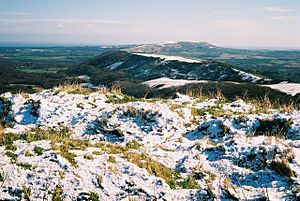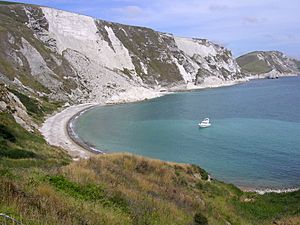Purbeck Hills facts for kids
The Purbeck Hills, also known as the Purbeck Ridge, are a line of chalk hills in Dorset, England. They were formed by a special geological fold called the Purbeck Monocline. These hills stretch from Lulworth Cove in the west all the way to Old Harry Rocks in the east, where they meet the sea.
The Purbeck Hills are part of a larger group of chalk hills in southern England. This group includes famous places like Salisbury Plain and the South Downs. For most of their length, the chalk of the Purbeck Hills is protected. A strong layer of Portland limestone stops the sea from wearing it away.
However, where this tough limestone layer ends, at Durlston Head, the softer clay and chalk behind it have been washed away. This created Poole Bay and The Solent. The ridge of chalk that forms the Purbeck Hills actually continues further east onto the Isle of Wight.
The height of these chalk hills and their closeness to Poole Harbour and the south coast have made them very important over time.
History of the Purbeck Hills
People have lived in the Purbeck Hills for a very long time. There are many old sites from the Iron Age, Roman times, and the Anglo-Saxons. One example is Nine Barrow Down.
At Corfe Castle, the hills are broken in two places. This leaves a steep, round hill between the ridges. A medieval castle once stood here. It guarded the only easy path through the hills. This castle was very important until the English Civil War in the 1600s, when it was destroyed.
Nature and Protection
Some parts of the ridge, especially near the village of Tyneham close to Lulworth, are used by the British Army as a firing range. Because of this, these areas have been protected from farming and new buildings.
Now, these parts are important nature reserves. At the eastern end, Ballard Down is a National Trust nature reserve. It is looked after because it has special calcareous grassland habitat. This type of grassland grows on chalky soil and is home to many unique plants and animals.
Main Hills of Purbeck
Here are some of the well-known hills in the Purbeck Ridge:
- Nine Barrow Down (199 meters high)
- Ridgeway Hill (199 meters high)
- Creech Barrow Hill (193 meters high) – Sometimes this hill is thought of as part of the Dorset Heaths.
- Bindon Hill (168 meters high) – This hill overlooks Lulworth Cove.
See also
 In Spanish: South Dorset Downs para niños
In Spanish: South Dorset Downs para niños



